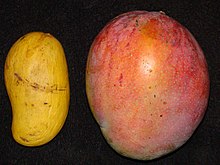Ataulfo (mango)

The Ataúlfo, also called young, baby, yellow, honey,[1][2] Adaulfo,[3] Adolfo,[4] or Champagne is a mango cultivar from Mexico.[5] Ataulfo mangos are golden yellow and generally weigh between 6 and 10 ounces (170 and 280 g), with a somewhat sigmoid (oblong) shape[5] and a gold-blushed yellow skin.[1] Their buttery flesh is not fibrous, and they have a thin pit.[5][6] Their flesh is a deep yellow and high in sugar (15 grams per 100-gram serving), with a rich, sweet flavor.[5][6] They are rich in vitamin C and dietary fiber.[1]
Origin
The Mexican Institute of Industrial Property (Instituto Mexicano de la Propiedad Industrial) granted the designation of origin of this fruit to the government of Chiapas.[citation needed] The land where this mango was found was owned by Mr. Manuel Rodriguez until 1948 when Mr. Ataulfo Morales (who worked as a jeweler) bought the property when mango trees were already there.
In 1958, the agronomist Hector Cano Flores (the discoverer of Ataulfo mango) reportedly made a clone of an Ataulfo mango which he named IMC-M2.[citation needed]
In 2003, the Mexican government, through the Official Gazette, published Comunicado No. 14 – 2003 titled “Abstract of the application for the declaration (protection) of the Appellation of Origin: Mango Ataulfo del Soconusco Chiapas,” a declaration that the term “Mango Ataulfo del Soconusco Chiapas” is an appellation of origin for a specific kind of mango fruit produced in several regions of Chiapas, Mexico.[7]
Production
The fruit grows in warm, moist climates with summer rains, but monsoon temperatures must not decline to 41 °F.[citation needed] The proper temperature for this type of mango is 83 °F with rainfall between 1090–3000 mm annually, from April to October.[citation needed]
The Ataulfo mangoes originate in the Mexican states of Michoacan, Sinaloa, Nayarit, Jalisco, Veracruz and Chiapas, and are sold between March and September.[1] In the Mexican state of Chiapas, mango production was, as of 2008, the sixth most important agricultural activity, based on cultivated surfaces, following corn, beans, coffee, sugar cane and cocoa.[citation needed] Ataulfo production in that state was concentrated in the Soconusco coastal region. Overall, producer organizations estimated that there were 18,000 hectares of Ataulfo mangoes in production in the state.[8]
Consumption
Ataulfo mangoes gained popularity in the United States beginning in the late 1990s, though they have been a major crop in Mexico for decades.[5] As of 2009, they were the second-most popular variety of mango sold in the United States, behind the Tommy Atkins.[9]
Ataulfo mangoes have not been sold in significant numbers in Europe because shipping them by air is prohibitively costly.[citation needed] But in December 2014, one United Kingdom importer indicated shipments of Ataulfo mangoes to the UK via seafreight, using a faster shipping service than before and having timed harvesting and the full ripening of the fruit while in transit.[10]
References
- ^ a b c d Corey Mintz (May 24, 2008). "Sweet news: Ataulfos are in season; It's hard to believe these silky mangoes are related to the stringy variety we see in winter". Toronto Star.
- ^ "Ataulfo Mango". Produce Oasis. May 2011.
- ^ Tony Tantillo (September 16, 2008). "Yellow Mangoes". CBS3.com.
- ^ Sue Doeden (April 26, 2009). "I'm mad about mangoes". Bemidji Pioneer.
- ^ a b c d e Allen Susser. The Great Mango Book. Ten Speed Press (2001), p. 6 ISBN 1-58008-204-1.
- ^ a b Aliza Green. Starting with Ingredients. Running Press (2006), p. 572. ISBN 0-7624-2747-7.
- ^ "Mango Variety Granted Appellation of Origin". INTA Bulletin, International Trademark Association. 1 May 2003. Retrieved 8 December 2015.
- ^ Patrick Hanemann, Nathanael Bourns, Ivana Fertziger (July 2008). "Ataulfo Mango in Chiapas: A Value Chain Analysis" (PDF).
{{cite web}}: CS1 maint: multiple names: authors list (link) (USAID microREPORT #109 - ^ Erica Marcus (June 10, 2009). "Mangoes win in popularity". St Louis Post-Dispatch.
- ^ Watson, Nichola (December 8, 2014). "First seafreight Ataulfo mangoes to UK". FreshPlaza.com. Retrieved 2015-05-15.

